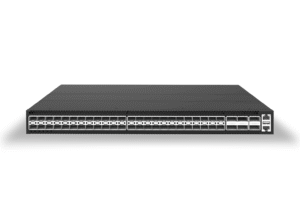Case Study (II): Network Architecture Optimization & Implementation at The Fourth Hospital of Hebei Medical University
written by Asterfuison
Project Background
The Fourth Hospital of Hebei Medical University, founded in 1955, is a comprehensive “Grade-A tertiary hospital” integrating medical treatment, teaching, scientific research, prevention, and healthcare. It employs over 4,000 staff members and occupies a building area of 250,000 square meters. The hospital has a wide range of connected devices, with each consultation room equipped with PCs and printers, numerous displays in public areas, and most medical equipment connected to the network. Due to the diverse types and large number of devices, as well as the high-frequency data transmission requirements, the hospital’s network faces a substantial load. The network needs to support the access of numerous terminal devices and mobile users.

Challenges and Needs
The Fourth Hospital of Hebei Medical University faces the following network architecture challenges:
- Large Number of Devices: The hospital has a wide variety of devices, and each consultation room and public area requires a large number of connected devices, leading to heavy traffic on the network.
- Strong Scalability Requirements: The hospital needs a flexible and efficient network architecture to support large-scale device access and accommodate mobile users.
- High-Reliability Requirements: As a medical institution, the hospital has very high stability and reliability requirements for its network, especially for critical medical equipment.
- High-Quality Wi-Fi Roaming: The hospital serves a large number of patients, and the Wi-Fi roaming domain needs to cover a wide area, especially the seamless roaming required across multiple floors.
Asterfusion Open Campus Network Solution
To address these challenges, we provided a comprehensive network architecture optimization solution, implemented as follows:
Network Architecture Design:

We chose a Spine-Leaf architecture with an aggregation layer in the middle, delivering exceptional scalability and reliability—ideal for handling the demands of large, dynamic campus networks.
- Configured 160 units CX206Y-48GT-M-H Leaf switches
- Configured 2 units of CX532P-M-H Super Spine switches
- Configured 8 units CX206P-24S-M-H aggregation switches at the aggregation layer
- This architecture not only enhanced the hospital’s traffic handling capacity but also expanded the network’s roaming domain, meeting the hospital’s need for large-scale user access.
Port Expansion and Redundancy Design:
Given the large hospital area and the massive device access demand, additional access ports were needed. We added 8 CX206P-24S aggregation switches between the Super Spine and Leaf switches to expand port capacity and support a larger roaming domain. By implementing MCLAG (Multi-Chassis Link Aggregation), we achieved link redundancy and failover, enhancing the overall network stability and fault tolerance.
Wi-Fi Roaming Optimization:
To address the issue of frequent Wi-Fi disconnections in the original hospital network, we introduced the innovative Anycast Gateway technology. This technology allows APs to directly forward traffic to upstream Leaf switches, avoiding the detouring issues that are common in traditional roaming scenarios, thereby improving network efficiency. The Anycast Gateway ensures that users maintain their original IP address while roaming, eliminating the need for reauthentication or reconnection. With the BGP-EVPN protocol, the Leaf switches and Spine switches share ARP table information, ensuring smooth traffic routing and client data synchronization, significantly enhancing the roaming experience across floors.
Unified Management and Monitoring through OpenWiFi Controller :
We provided the hospital with unified network management and monitoring capabilities through the OpenWiFi Controller software, enabling real-time monitoring of network status and quick issue resolution. This platform not only improved network maintenance efficiency but also enhanced response speed, ensuring that the hospital’s network continues to operate stably under high load.
Implementation Results
Through the network architecture optimization, the network performance and management efficiency at The Fourth Hospital of Hebei Medical University were significantly enhanced:
- Increased Device Support Capability: The hospital’s terminal devices, medical equipment, PCs, printers, etc., are now able to reliably connect to the network, with effective management of the network load.
- Enhanced Scalability and Flexibility: The Spine-Leaf architecture provides high flexibility, allowing the network to support the future expansion of devices and users.
- Significantly Improved Network Reliability: The application of MCLAG technology has ensured high network reliability, reduced the likelihood of network failures, and provided strong support, particularly for critical medical devices.
- Simplified and unified Management Platform: The unified management platform reduced maintenance workload, improved management efficiency, and ensured the stability and effectiveness of the network.
Customer Feedback
” We greatly appreciate the professional network solution provided by the Asterfusion team. The new network architecture not only meets our high-performance demands but also provides substantial support in scalability and reliability. In particular, the network has shown excellent stability in supporting our medical devices and mobile users, ensuring that the daily operations of the hospital are unaffected. We are extremely satisfied with this collaboration and look forward to further cooperation with Asterfusion in the future.”
— Head of Network Management, The Fourth Hospital of Hebei Medical University
Summary
Through this network optimization, the hospital successfully addressed several network pain points:
- The three-tier architecture provided more ports and a larger roaming domain, particularly fulfilling the seamless roaming requirements across floors.
- The combination of Anycast Gateway technology and BGP-EVPN protocol enhanced the Wi-Fi roaming experience, ensuring IP address consistency and data synchronization for clients.
- The OpenWiFi Controller unified maintenance platform simplified operational tasks, increased efficiency, and ensured smooth network performance.
This optimization solution not only significantly improved the hospital’s network performance but also provided a solid foundation for future expansion and upgrades, ensuring the continuous and stable operation of medical services.






